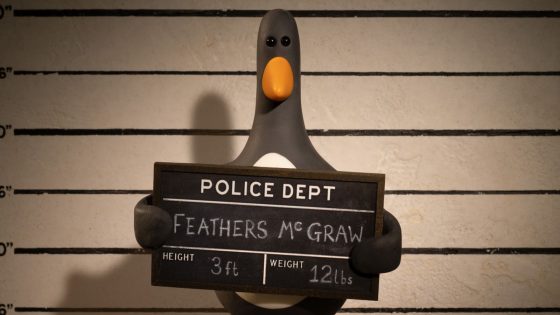Day 68:40The stars of The Blair Witch Project reckon with its complicated legacy
In 1999, Michael C. Williams was on top of the world.Â
The actor was making an appearance on Late Night with Conan O’Brien after co-starring in The Blair Witch Project, the found-footage horror film that rattled millions of moviegoers’ bones.
A year and a half later, acting work had dried up and Williams was selling hot dogs at a restaurant on Hollywood Boulevard. One day, his customer was comedian and O’Brien’s co-host Andy Richter.
“He kind of gave me one of those empathetic looks and kind of said, ‘What happened, man? Why are you flipping hot dogs? That movie made more money than God,'” Williams recalled.
“I said, if I knew, I wouldn’t be here.”
Williams and co-star Joshua Leonard, who continue to work in the film industry, spoke to Day 6 about the unusual nature of The Blair Witch Project, which left a lasting imprint on horror media when it was released in 1999 â but also the real-life long-term scars it left on them and their co-star Heather Donahue.
The trio faced hate and harassment from people who felt duped by the movie’s marketing, and have continued to call for fair compensation and residual payments related to the film’s franchise, which has only grown in the past 25 years.
“It’s been rough, and there have been aspects of trauma,” said Leonard.
“Nobody has ever stepped in from the studio side ⦠to say, ‘Oh man, that must have been hard. Maybe we can give you a heads up next time [a sequel is] going to come out. Maybe we can help you pay for the therapy bills that you’ve been paying over 20 years.'”

Written and directed by Daniel Myrick and Eduardo Sánchez, the film told the story of three young adults who venture into the woods to film a documentary about a local legend known as the Blair Witch.
The film is shot to replicate camcorder footage captured for a documentary by the characters, found a year after their disappearance and presumed deaths. Williams, Leonard and Donahue starred as amateur filmmakers and used their real names in the movie.
“For me, it was really exciting to be a part of something that was that experimental,” said Williams.
An ‘extraordinary work of dread and horror’
Peter Kuplowsky was all in with The Blair Witch Project’s marketing mystique as a middle schooler in 1999 â even though he recalls being too scared to actually watch it at the time.
“I cut out articles about it in the newspaper, I have a Time magazine with the filmmakers on the cover. I watched the TV documentary that acted as if this was a real piece of found footage,” said Kuplowsky, senior programmer for Toronto International Film Festival’s Midnight Madness â a program of what he describes as the “scariest, strangest and most exhilarating genre movies.”
He finally watched it many years later as research while shooting his own film in the woods. “I think it’s a really extraordinary work of dread and horror filmmaking,” he said.
WATCH |Â Trailer for 1999’s The Blair Witch Project:
It was also a great example of folk horror, building the myth of the Blair Witch with second-hand, sometimes contradictory stories that speak to unknown powers older than us, he said.
“I think the scariest thing about [the film] is all the stuff you can’t see, but you have the sense that it’s out there.”
Fact or fiction
The Blair Witch Project made over $250 million US, a record for independent films at the time. The lead actors’ initial payday, however, was $1,000 US per actor for two weeks of filming. They were eventually paid a settlement of $300,000 US in 2004, but this locked them out of future residuals, according to the New York Times.
Using their real names in the film also led to unexpected consequences.
To help build the suspense of whether the footage and story was real, the actors were instructed to go dark for nearly a month after its launch, only appearing on talk shows and magazine covers after the initial buzz had died down.
Close friends and family members knew the nature of the project but were bombarded with inquiries asking if Michael, Joshua and Heather had actually disappeared. For a short while, their IMDb profiles listed them as dead, Williams said.

That blurring between fact and fiction meant the actors had trouble landing new roles. Williams recalled speaking to one casting director who simply did not believe they were acting in The Blair Witch Project, but were recording themselves having an authentic breakdown.
On top of the confusion, Leonard said they were targeted with harassment and hate â at least in part because some viewers thought the marketing had misled them into thinking the film was a real recounting of events.
Donahue endured “a level of vitriol that Mike and I never even had to touch,” Leonard said, amplified further by misogynistic attacks on her. Donahue has since legally changed her name and retired from acting. She declined an interview with Day 6.
Kuplowsky said it’s likely no imitator will be able to blur the line between fiction and non-fiction to the level the 1999 original did â and that perhaps that’s for the best.
“It’s maybe a magic trick you can only do once. And there were clearly consequences from pulling that off,” he said.
Call for residuals, consultation
In April, Leonard posted on social media calling on film studio Lionsgate to pay himself, Williams and Donahue retroactive and future residual payments for their appearances in The Blair Witch Project, as well as “meaningful consultation” for future sequels and related multimedia.
It came shortly after Lionsgate announced a reboot of the series; the original actors said they were not contacted or involved in the project, even though archival clips and images of them appear in promotional materials.
“It’s not even about the money. It’s just about being seen and respected and acknowledged for something that continues to affect us as human beings,” said Leonard.
CBC reached out to Lionsgate for comment about Leonard’s open letter, but the studio declined to comment.

Despite the strange road he and his co-stars have been through, Leonard is grateful for the “sacred relationship” he’s been able to enjoy with fans of the film.
He recalled once meeting a mother and daughter at a convention. The mother brought a Blair Witch T-shirt that was a beloved possession of her late son who had recently died of an overdose.
“They approached us and they were both weeping, and she said, ‘I can’t believe I’m meeting you guys,'” he recalled.
The man’s mother told Leonard that getting them to sign this shirt made her feel like she was with her son again.
“Sometimes that’s what gets me through the day [is] to be able to have that kind of experience with somebody and really relate on the deepest human level…. It gives some validation to why we do it.”
Source Agencies



